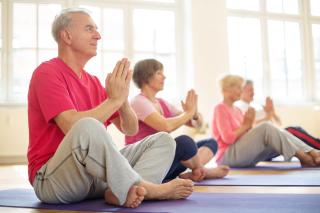If you’re feeling anxious or stressed, perhaps it’s time to meditate. If it feels like you’re too busy to prioritize meditation, you may need an even longer session.
Going Back to the Basics: The Healing Power of Ancestral Meditation and Mindfulness Practices
The cutting-edge Peloton bike rose to fame during the pandemic and gave millions of people a sense of community during an unusually trying time for everyone. The bike allowed users to lean into their competitive side and share workout metrics with other riders while virtually connecting with fun, influential instructors giving real-time shoutouts to riders during classes. Where stay-at-home orders prompted feelings of isolation and increasingly sedentary lifestyles replaced frequent gym visits and nature hikes, the Peloton bike did wonders for morale in the fitness community.
Modern medicine and cutting-edge workout apparatuses like the Peloton are certainly convenient and beneficial for promoting optimal health and wellness, but when it comes to ancestral wisdom and healing practices that have existed for thousands and thousands of years, going back to the basics can be as simple and easy as it is free and accessible.
This is especially true for meditation and mindfulness practices that have proven to improve mental and physical health, reduce stress and anxiety, improve memory and cognition, and boost the immune system.
What is the difference between mindfulness and meditation, and how does one begin to implement a mindfulness and meditation practice? Let’s look at what mindfulness and meditation really are, the differences between the two, and a step-by-step guide to easily implement a new meditation and mindfulness routine in your life to feel your best from the inside out.
What is the Difference Between Mindfulness and Meditation?
In short, mindfulness is the quality or state of being aware and conscious of your state of being. Meditation, however, is a dedicated practice that involves focusing and clearing your mind to achieve a deep state of relaxation and calmness for a set duration. Mindfulness is the adjective or noun, and meditation is the verb—but both work synergistically to deliver numerous health benefits.
To gain a clearer understanding, here are a few other key differences between mindfulness and meditation:
- Meditation is one of many methods available to achieve more mindfulness in your day-to-day life
- Mindfulness does not require meditation, but meditation requires mindfulness
- Meditation is associated with being still and not doing, whereas mindfulness can take place at any time, during any event
- Mindfulness is an aspect of meditation, but other elements are important in meditation practices, like deep breathing and other spiritual practices
Benefits of Mindfulness and Meditation
Whether you are engaging in mindfulness and meditation together or just one or the other, you stand to gain significant returns in the investment of your health and wellness. The benefits are even more substantial for older adults who may struggle with aging-related difficulties such as fear, anxiety, physical and mental changes, and declining cognition. The benefits include:
- Stress management
- Anxiety relief
- Improved sleep quantity and quality
- Pain relief or reduction
- Improved memory and cognitive function
- Elevated moods and a more positive outlook
- More self-compassion and a sense of connection with others
How to Start and Maintain a Mindfulness and Meditation Practice
Trying anything new can feel uncomfortable and overwhelming. But even those Buddhist monks who stay in a perfect state of peace and calm started as beginners. Follow this step-by-step guide to start and maintain your own mindfulness and meditation practice in your own life to reap amazing benefits in your mind and body.
- Find a peaceful place and sit in a comfortable position. You’ll want to eliminate any potential distractions like a ringing cell phone or a noisy television show. Take a deep breath and relax as much as possible, and set an intention to let go of any distractions or stressors during the meditation. During this step, you can set an intention for your day or the meditation itself. Common intentions for meditation include, “I intend to see the goodness around me,” “I will feel peace and calmness today despite any challenges that arise,” or “I will show myself compassion today.”
- Close your eyes and pay attention to the present moment. As a beginner, you’ve not yet learned to tune out or mute any distractions, including your own thoughts, but this is the goal and will come with practice (mindfulness practice, to be exact!). In the meantime, this is your chance to be fully present and focus on finding calmness and clarity. The goal is to eliminate cluttered, overwhelming, and/or negative thoughts and save space for quietness and reflection. Pay close attention to your body and any sensations you are experiencing, starting from the bottom of your feet and working your way up to your upper body. Keep an upright posture throughout.
- Focus on your breathing. During daily life, different stressors and challenges cause us to breathe shallowly, and we often don’t even notice. You should practice inhaling deeply through the nose and breathing out through the mouth. A common deep-breathing technique is called 4-7-8: Breathe in through your nose while counting to four. Hold the breath inside your lungs, feeling your chest and belly expand to the count of seven. Then exhale through your mouth to the count of eight. Start your meditation with a few deep belly breaths. When you begin to feel distracted, bring your attention back to your breath, being fully present in your mind and body, and being reminded of the intention you set.
- Aim to settle your mind throughout the meditation. As you experience your meditation practice, you’ll notice how easily the mind wanders and swings from one thought to another. When you latch onto distracted thoughts, regain awareness of your present body and your breathing to refocus.
- Start small and work your way up. You’ll want to set a timer for each meditation you start, but it may be too much of an undertaking to dive right into a 20-minute practice. Start with five minutes and work your way up as you become more experienced at quieting distracting or negative thoughts and feel more comfortable spending more time doing this exercise.
“You should sit in meditation for twenty minutes every day—unless you're too busy; then you should sit for an hour.” Dr. Sukhraj Dhillon




